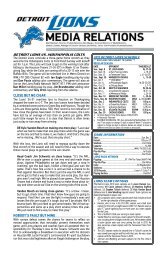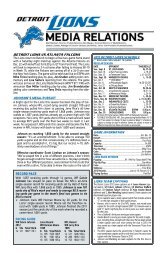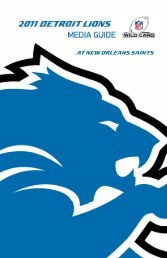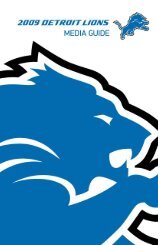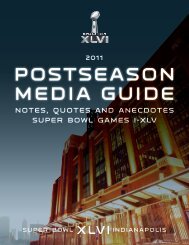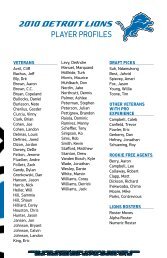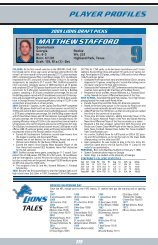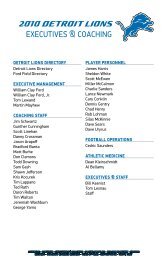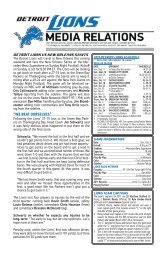detroit lions vs. st. louis rams the season begins consistency up front ...
detroit lions vs. st. louis rams the season begins consistency up front ...
detroit lions vs. st. louis rams the season begins consistency up front ...
Create successful ePaper yourself
Turn your PDF publications into a flip-book with our unique Google optimized e-Paper software.
DETROIT LIONS UNIFORM HISTORY<br />
1934-1947: The fi r<strong>st</strong> uniform donned<br />
by <strong>the</strong> Detroit Lions included a blue<br />
jersey with gleaming silver numerals,<br />
silver pants and a silver helmet. The<br />
shoes were black. The shade of blue<br />
used for <strong>the</strong> jersey became known as<br />
‘Honolulu’ blue.<br />
1948: Alvin ‘Bo’ McMillin joined <strong>the</strong><br />
Lions a er having success as a college<br />
coach at Indiana University. Soon<br />
a er his arrival, McMillin changed <strong>the</strong><br />
colors of <strong>the</strong> Lions’ uniforms with <strong>the</strong><br />
new colors resembling those of his<br />
Hoosier teams. The organization retained Honolulu blue and<br />
silver as <strong>the</strong>ir offi cial colors<br />
The jersey was scarlet with white numbers<br />
and <strong>the</strong> pants were white with a thin black<br />
<strong>st</strong>ripe between two thin scarlet <strong>st</strong>ripes. The<br />
helmets were black. All <strong>the</strong> players wore<br />
lea<strong>the</strong>r helmets that <strong>season</strong> due to <strong>the</strong><br />
league’s ban on pla<strong>st</strong>ic helmets.<br />
The team had a second, all-black uniform,<br />
which would be worn only for certain important<br />
games that McMillin particularly<br />
wished to win. The jersey was black with<br />
white numbers and <strong>the</strong> pants were black<br />
with a thin scarlet <strong>st</strong>ripe between two thin<br />
white <strong>st</strong>ripes.<br />
The two uniform sets ended <strong>up</strong> being worn<br />
in four diff erent combinations (scarlet/white; black/black; scarlet/<br />
black; black/white).<br />
1949: The Lions returned to wearing <strong>the</strong>ir Honolulu blue and<br />
silver uniforms at home but continued to wear combinations of<br />
<strong>the</strong> scarlet and white uniforms and <strong>the</strong> all-black uniforms on<br />
<strong>the</strong> road. The team changed <strong>the</strong> color of <strong>the</strong>ir helmet to blue<br />
and some players went back to wearing pla<strong>st</strong>ic helmets a er<br />
<strong>the</strong> NFL li ed <strong>the</strong> ban on pla<strong>st</strong>ic headgear from <strong>the</strong> previous<br />
<strong>season</strong>.<br />
1950-55: A er wearing fi ve diff erent combinations<br />
of scarlet, white, black, silver and Honolulu<br />
blue in <strong>the</strong> previous two <strong>season</strong>s, <strong>the</strong> Lions<br />
went back to wearing <strong>the</strong> traditional Honolulu<br />
blue and silver uniforms at home and on <strong>the</strong><br />
road. For mo<strong>st</strong> of <strong>the</strong> 1950 <strong>season</strong> <strong>the</strong> team<br />
wore blue helmets but went back to wearing silver helmets for<br />
<strong>the</strong> 1951 <strong>season</strong>. During <strong>the</strong> early 50’s, <strong>the</strong> NFL did not allow<br />
<strong>the</strong> Lions to wear silver helmets for night games because of<br />
<strong>the</strong>ir resemblance to <strong>the</strong> white ball under <strong>the</strong> night lights. They<br />
spray-painted <strong>the</strong>ir helmets blue for night games. Also, in 1951,<br />
<strong>the</strong> Lions wore <strong>the</strong> Detroit 250th Anniversary patch on <strong>the</strong>ir le<br />
sleeve. The patch was also worn by <strong>the</strong> Red Wings and Tigers.<br />
1956: This was <strong>the</strong> fi r<strong>st</strong> <strong>season</strong> that <strong>the</strong> Lions added <strong>the</strong>ir<br />
uniform numbers to <strong>the</strong> arm sleeves. Some players, like Lions<br />
Hall of Fame LT Lou Creekmur, were unhappy with <strong>the</strong> change –<br />
claiming that it made it harder to get away with holding.<br />
1957-60: The Lions began wearing separate<br />
colored uniforms on <strong>the</strong> road on a permanent<br />
basis in 1957. The jersey was white with three<br />
blue <strong>st</strong>ripes, one thick between two thin<br />
<strong>st</strong>ripes, on <strong>the</strong> sleeves. The numbers were<br />
blue and <strong>the</strong> helmet and pants remained silver.<br />
They wore a white jersey on at lea<strong>st</strong> one o<strong>the</strong>r<br />
occasion in a previous <strong>season</strong>. On October 24,<br />
1954, <strong>the</strong> Lions wore a similar white uniform<br />
in a game at San Francisco which <strong>the</strong>y lo<strong>st</strong>, 37-31, to <strong>the</strong> 49ers.<br />
1961-67: In 1961, William Clay Ford’s fi r<strong>st</strong> <strong>season</strong> as <strong>the</strong><br />
team’s president, <strong>the</strong>re were some signifi cant uniform changes.<br />
The helmet remained silver with a grey facemask but now had<br />
<strong>the</strong> leaping-lion logo as well as two vertical blue <strong>st</strong>ripes running<br />
from <strong>the</strong> back to <strong>the</strong> <strong>front</strong>. The pants also had two vertical<br />
blue <strong>st</strong>ripes. Three silver <strong>st</strong>ripes, one thick between two thin,<br />
were added to <strong>the</strong> arm sleeves of <strong>the</strong> home jersey. The away<br />
jersey remained <strong>the</strong> same.<br />
During <strong>the</strong> mid-60s, many players cut off<br />
part of <strong>the</strong> sleeves–giving appearance of<br />
only one or two <strong>st</strong>ripes.<br />
1968-69: 1968 was <strong>the</strong> fi r<strong>st</strong> year <strong>the</strong><br />
Lions had a white <strong>st</strong>ripe between <strong>the</strong><br />
two blue <strong>st</strong>ripes on <strong>the</strong> helmet. The Lions<br />
and <strong>the</strong> re<strong>st</strong> of <strong>the</strong> league wore <strong>the</strong><br />
NFL 50th Anniversary patch on <strong>the</strong>ir le<br />
shoulder in 1969.<br />
1970-71: La<strong>st</strong> names were added to <strong>the</strong> back of <strong>the</strong> players’<br />
jerseys in silver lettering and white trim was added to <strong>the</strong> Leaping<br />
Lion logo on <strong>the</strong> helmet in 1970.<br />
For <strong>the</strong> second half of <strong>the</strong> 1971 <strong>season</strong>, <strong>the</strong> Lions wore a black<br />
band, which was sewn over <strong>the</strong> thick <strong>st</strong>ripe on <strong>the</strong> le sleeve<br />
on <strong>the</strong>ir home and away jerseys, in honor of wide receiver<br />
Chuck Hughes. Hughes died of a heart attack with 62 seconds<br />
remaining in <strong>the</strong> fourth quarter again<strong>st</strong> <strong>the</strong> Chicago Bears on<br />
October 24, 1971.<br />
1972: The Honolulu blue home jersey had white trim on <strong>the</strong><br />
silver numerals and <strong>the</strong> white jerseys had silver trim on blue<br />
numerals for <strong>the</strong> fi r<strong>st</strong> time in 1972. It was also <strong>the</strong> fi r<strong>st</strong> year<br />
that <strong>the</strong>re was a white, vertical <strong>st</strong>ripe between <strong>the</strong> two blue<br />
<strong>st</strong>ripes on <strong>the</strong> pants.<br />
The Lions tweaked <strong>the</strong> <strong>st</strong>riping on <strong>the</strong> arm-sleeves for that <strong>season</strong><br />
as well. The home jerseys had <strong>the</strong> one thick silver <strong>st</strong>ripe between<br />
two thin white <strong>st</strong>ripes and <strong>the</strong> away jersey had <strong>the</strong> one thick blue<br />
<strong>st</strong>ripe between to thin silver <strong>st</strong>ripes.<br />
1973-75: Detroit changed back to <strong>the</strong> three silver <strong>st</strong>ripes, one<br />
thick between two thin, on <strong>the</strong> sleeves of <strong>the</strong> Honolulu blue<br />
home jersey except now <strong>the</strong>y had white trim. The away white<br />
jersey had three blue <strong>st</strong>ripes, one thick between two thin, and<br />
<strong>the</strong>y had silver trim.<br />
For <strong>the</strong> 1974 <strong>season</strong>, <strong>the</strong> Lions wore a black band,<br />
which was sewn over <strong>the</strong> thick <strong>st</strong>ripe on <strong>the</strong> le<br />
sleeve of <strong>the</strong>ir home and away jerseys, in honor<br />
of Head Coach Don McCaff erty who died of a heart<br />
attack during training camp.<br />
1974 was also <strong>the</strong> <strong>season</strong> that <strong>the</strong> Lions <strong>st</strong>arted<br />
wearing white shoes.<br />
1976-79: In 1976, <strong>the</strong> players’ numbers were added to <strong>the</strong><br />
back of <strong>the</strong> helmet.<br />
1980-81: The Lions changed <strong>the</strong> dull silver <strong>st</strong>ripes and trimming<br />
on <strong>the</strong>ir uniforms to a shimmering silver glitter. This only<br />
la<strong>st</strong>ed two <strong>season</strong>s because of complaints by o<strong>the</strong>r teams<br />
about <strong>the</strong> glare.<br />
1982-97:<br />
1982: The Lions changed <strong>the</strong> color of <strong>the</strong> numbers on <strong>the</strong>ir home<br />
jerseys, making <strong>the</strong>m white with silver trim.<br />
1983: The Lions wore a 50th Anniversary patch on <strong>the</strong>ir le<br />
shoulder. The Lions changed <strong>the</strong>ir facemask from silver/grey to<br />
Honolulu blue.<br />
1991: The team wore a patch honoring Russ<br />
Thomas, a former player and General Manager<br />
for <strong>the</strong> Lions, who had recently passed away.<br />
For <strong>the</strong>ir final seven games (five regular<br />
<strong>season</strong>, two po<strong>st</strong><strong>season</strong>), each player had a<br />
white circle decal with a blue number ’60,’<br />
on <strong>the</strong> back right side of <strong>the</strong> helmet, in honor<br />
of RG Mike Utley. Utley suff ered a spinal cord<br />
injury in a game again<strong>st</strong> <strong>the</strong> Los Angeles Rams<br />
on November 17, 1991. The small NFL shield was added to <strong>the</strong><br />
‘V’ of <strong>the</strong> neck.<br />
1992: They wore a black circle decal with a white number ‘65,’<br />
on <strong>the</strong> back right side of <strong>the</strong> helmet, in honor of LG Eric Andolsek,<br />
who was killed a few months prior to <strong>the</strong> <strong>season</strong>.<br />
1993: The Lions wore a 60th Anniversary patch on <strong>the</strong>ir le<br />
shoulder.<br />
1994: The Lions wore throwback jerseys for <strong>the</strong> 1994 <strong>season</strong> while<br />
<strong>the</strong> NFL was celebrating <strong>the</strong>ir 75th anniversary. This version of <strong>the</strong><br />
uniform was intended to replicate <strong>the</strong> jersey worn by <strong>the</strong> Lions in<br />
1935, which was <strong>the</strong> <strong>season</strong> that <strong>the</strong> team won <strong>the</strong>ir fi r<strong>st</strong> world<br />
championship. Several players wore a black circle decal with a<br />
white number ’50,’ on <strong>the</strong> back right side of <strong>the</strong> helmet in honor<br />
of former Lions’ LB Toby Ca<strong>st</strong>on.



